
Round nose pliers, often called rosary pliers in the jewelry trade, are a specialized type of pliers characterized by their jaws of approximately round cross-section, usually of smooth surface finish and diameter tapering toward the tips.

Round nose pliers, often called rosary pliers in the jewelry trade, are a specialized type of pliers characterized by their jaws of approximately round cross-section, usually of smooth surface finish and diameter tapering toward the tips.
Round nose pliers are commonly used in electronics [1] and electrical wiring for forming a loop at the end of a wire and in jewelry making to form a variety of bends in wire. [2]

Often, round nose pliers have insulated handles for safe electrical work, a spring-fitted joint for ready opening and closing, and comfortable grips on the handles to make them easy to manipulate.
Variations particularly favored by jewelers and beadsmiths include one of the jaws flat rather than round (for making chain), jaws of differing diameters or non-tapered jaws which are used to make findings such as bails, jump rings and toggle clasps for wearable items.

A wire is a single usually cylindrical, flexible strand or rod of metal. Wires are used to bear mechanical loads or electricity and telecommunications signals. Wire is commonly formed by drawing the metal through a hole in a die or draw plate. Wire gauges come in various standard sizes, as expressed in terms of a gauge number. The term 'wire' is also used more loosely to refer to a bundle of such strands, as in "multistranded wire", which is more correctly termed a wire rope in mechanics, or a cable in electricity.
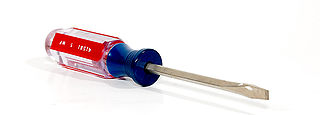
A screwdriver is a tool, manual or powered, used for screwing (installing) and unscrewing (removing) screws. A typical simple screwdriver has a handle and a shaft, ending in a tip the user puts into the screw head before turning the handle. This form of the screwdriver has been replaced in many workplaces and homes with a more modern and versatile tool, a power drill, as they are quicker, easier, and also can drill holes. The shaft is usually made of tough steel to resist bending or twisting. The tip may be hardened to resist wear, treated with a dark tip coating for improved visual contrast between tip and screw—or ridged or treated for additional 'grip'. Handles are typically wood, metal, or plastic and usually hexagonal, square, or oval in cross-section to improve grip and prevent the tool from rolling when set down. Some manual screwdrivers have interchangeable tips that fit into a socket on the end of the shaft and are held in mechanically or magnetically. These often have a hollow handle that contains various types and sizes of tips, and a reversible ratchet action that allows multiple full turns without repositioning the tip or the user's hand.
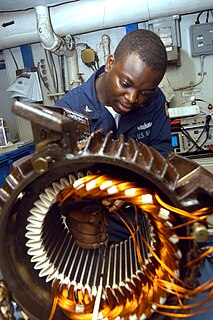
An electrician is a tradesman specializing in electrical wiring of buildings, transmission lines, stationary machines, and related equipment. Electricians may be employed in the installation of new electrical components or the maintenance and repair of existing electrical infrastructure. Electricians may also specialize in wiring ships, airplanes, and other mobile platforms, as well as data and cable lines.

A file is a tool used to remove fine amounts of material from a workpiece. It is common in woodworking, metalworking, and other similar trade and hobby tasks. Most are hand tools, made of a case hardened steel bar of rectangular, square, triangular, or round cross-section, with one or more surfaces cut with sharp, generally parallel teeth. A narrow, pointed tang is common at one end, to which a handle may be fitted.

Pliers are a hand tool used to hold objects firmly, possibly developed from tongs used to handle hot metal in Bronze Age Europe. They are also useful for bending and compressing a wide range of materials. Generally, pliers consist of a pair of metal first-class levers joined at a fulcrum positioned closer to one end of the levers, creating short jaws on one side of the fulcrum, and longer handles on the other side. This arrangement creates a mechanical advantage, allowing the force of the hand's grip to be amplified and focused on an object with precision. The jaws can also be used to manipulate objects too small or unwieldy to be manipulated with the fingers.

Tweezers are small tools used for picking up objects too small to be easily handled with the human fingers. The tool is most likely derived from tongs, pincers, or scissors-like pliers used to grab or hold hot objects since the dawn of recorded history. In a scientific or medical context they are normally referred to as forceps.
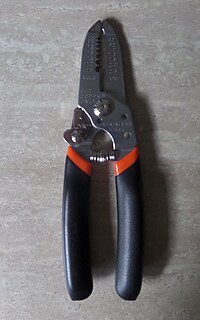
A wire stripper is a small, hand-held device used to strip the electrical insulation from electric wires.
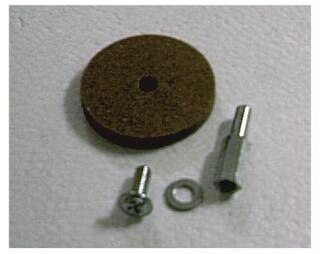
A mandrel, mandril, or arbor is:

Swaging is a forging process in which the dimensions of an item are altered using dies into which the item is forced. Swaging is usually a cold working process, but also may be hot worked.

A collet is a subtype of chuck that forms a collar around an object to be held and exerts a strong clamping force on the object when it is tightened, usually by means of a tapered outer collar. It may be used to hold a workpiece or a tool.

A chuck is a specialized type of clamp used to hold an object with radial symmetry, especially a cylinder. In drills and mills it holds the rotating tool whereas in lathes it holds the rotating workpiece. On a lathe the chuck is mounted on the spindle which rotates within the headstock. For some purposes an additional chuck may be mounted on the non-rotating tailstock.

A draw plate is type of die consisting of a hardened steel plate with one or more holes through which wire is drawn to make it thinner. A typical plate will have twenty to thirty holes so a wide range of diameters can be drawn.

Crimping is joining two or more pieces of metal or other ductile material by deforming one or both of them to hold the other. The bend or deformity is called the crimp.
Diagonal pliers are pliers intended for the cutting of wire. The plane defined by the cutting edges of the jaws intersects the joint rivet at an angle or "on a diagonal", hence the name.
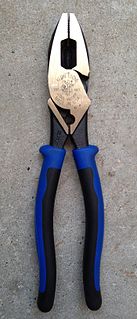
Lineman's pliers, Kleins, linesman pliers and combination pliers, or side-cutting pliers are a type of pliers used by linemen, electricians, and other tradesmen primarily for gripping, twisting, bending and cutting wire, cable and small metalwork components. They owe their effectiveness to their plier design, which multiplies force through leverage.

Jewelry wire is wire, usually copper, brass, nickel, aluminium, silver, or gold, used in jewelry making.
Stonesetting is the art of securely setting or attaching gemstones into jewelry.

Wire wrapping is one of the oldest techniques for making handmade jewelry. This technique is done with jewelry wire and findings similar to wire to make components. Wire components are then connected to one another using mechanical techniques with no soldering or heating of the wire. Frequently, in this approach, a wire is bent into a loop or other decorative shape and then the wire is wrapped around itself to finish the wire component. This makes the loop or decorative shape permanent. The technique of wrapping wire around itself gives this craft its name of wire wrapping.

Locking pliers are pliers that can be locked into position, using an over-center toggle action.

An ironworker is a tradesman who works in the iron-working industry. Ironworkers assemble the structural framework in accordance with engineered drawings and install the metal support pieces for new buildings. They also repair and renovate old structures using reinforced concrete and steel. Ironworkers may work on factories, steel mills, and utility plants.